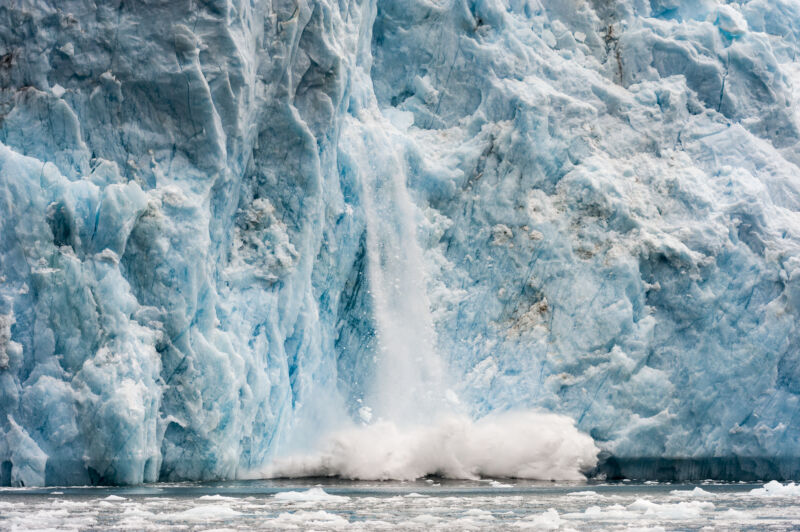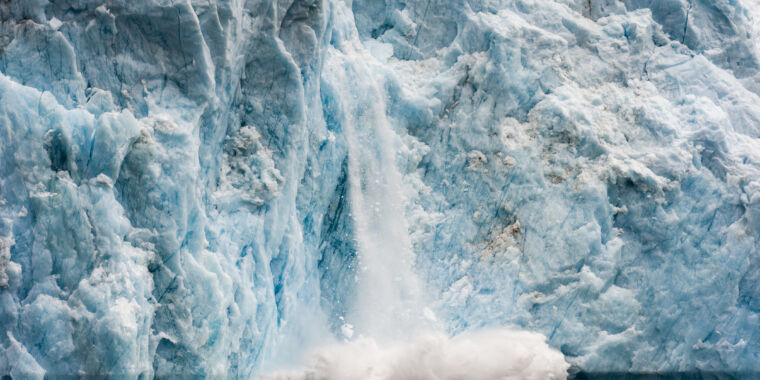
Earthquake scientists detected an unusual signal at monitoring stations used to track seismic activity in September 2023. We saw it on sensors everywhere from the Arctic to Antarctica.
We were astonished: the signal was unlike anything we had ever heard before. Instead of the frequency-rich rumble typical of earthquakes, this was a monotonous hum, with only one vibration frequency. Even more puzzling, the signal continued for nine days.
Initially classified as a “USO” — an unidentified seismic object — the source of the signal was eventually traced to a massive landslide in Greenland’s remote Dickson Fjord. A staggering volume of rock and ice, enough to fill 10,000 Olympic swimming pools, crashed into the fjord, triggering a 200-meter-high mega-tsunami and a phenomenon known as a seiche: a wave in the icy fjord that sloshed back and forth some 10,000 times over nine days.
To put the tsunami in context, that 200-meter-high wave was twice as tall as London’s Big Ben tower and many times higher than anything recorded after massive undersea earthquakes in Indonesia in 2004 (the Boxing Day tsunami) or Japan in 2011 (the tsunami that hit the Fukushima nuclear power plant). It may have been the biggest wave on Earth since 1980.
Our discovery, now published in the journal Science, was based on collaborations with 66 other scientists from 40 institutions in 15 countries. Like investigating a plane crash, solving this mystery required piecing together many different pieces of evidence, from a wealth of seismic data to satellite imagery, water-level monitors in fjords and detailed simulations of how the tsunami wave developed.
All of this underscored a catastrophic, sequential series of events, spanning decades to seconds before the collapse. The landslide traveled down a steep glacier into a narrow gorge before plunging into a narrow, confined fjord. Ultimately, however, it was decades of global warming that had thinned the glacier by tens of meters, meaning that the mountain that towered above it could no longer be held.
Uncharted waters
But beyond the strangeness of this scientific miracle, this event underscores a deeper and more disturbing truth: Climate change is changing our planet and our scientific methods in ways we are only beginning to understand.
It’s a stark reminder that we’re sailing through uncharted waters. Just a year ago, the idea that a seiche could last for nine days would have been dismissed as absurd. A century ago, the idea that warming could destabilize Arctic slopes, triggering massive landslides and tsunamis that occur almost annually, would have seemed far-fetched. Yet these once unthinkable events are now our new reality.
The “once unthinkable” has consequences for the entire world.
As we move deeper into this new era, we can expect to see more phenomena that defy our previous understanding, simply because our experience does not include the extreme conditions we are now encountering. We found a nine-day wave that no one could have imagined before.
Traditionally, discussions about climate change have focused on us looking up and out at the atmosphere and oceans with changing weather patterns and rising sea levels. But Dickson Fjord forces us to look down at the crust beneath our feet.
For perhaps the first time, climate change has triggered a seismic event with global implications. The Greenland landslide sent tremors through the Earth, shaking the planet and creating seismic waves that traveled around the world within an hour of the event. No piece of ground beneath our feet was immune to these tremors, figuratively opening up cracks in our understanding of these events.
This will happen again
Although landslides and tsunamis have been recorded before, the September 2023 tsunami was the first ever recorded in East Greenland. The area seemed immune to these catastrophic events caused by climate change.
This will certainly not be the last time such a landslide megatsunami occurs. As permafrost on steep slopes continues to warm and glaciers thin, we can expect to see more of these events and on larger scales in the world’s polar and mountainous regions. Recently identified unstable slopes in western Greenland and Alaska are prime examples of impending disasters.

Gabe Wolken/USGS
As we face these extreme and unexpected events, it is becoming clear that our existing scientific methods and toolkits must be fully equipped to deal with them. We did not have a standard workflow to analyze the 2023 Greenland event. We also need to adopt a new mindset, because our current understanding is shaped by a now nearly extinct, previously stable climate.
As we continue to change our planet’s climate, we must be prepared for unexpected phenomena that challenge our current understanding and require new ways of thinking. The ground beneath us is shaking, both literally and figuratively. While the scientific community must adapt and pave the way for informed decisions, it is up to decision makers to act.
The authors elaborate on their findings.
Stephen Hicks is a researcher in computational seismology at UCL and Kristian Svennevig is a senior researcher in the mapping and mineral resources department of the Geological Survey of Denmark and Greenland.
This article is republished from The Conversation under a Creative Commons license. Read the original article.

